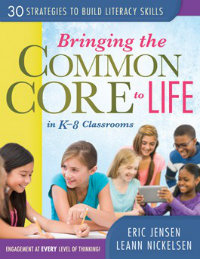Enliven the CC Classroom with These Literacy Strategies
Bringing the Common Core to Life in K-8 Classrooms: 30 Strategies to Build Literacy Skills
By Eric Jensen & LeAnn Nickelsen
(Solution Tree, December 2013 – Learn more)

Engagement is an essential piece of the puzzle when it comes to student learning. Bringing the Common Core to Life in K-8 Classrooms offers fresh ideas and resources to captivate, challenge and engage students.
“If we want students to enjoy and participate in the learning process, remember what was learned, apply information at higher levels, and feel the content is valued and respected, then we must engage them,” say authors Eric Jensen and LeAnn Nickelsen. Their book combines easy-to-use strategies for the CCSS that will bring lessons to life and assure active participants.
The ground work for engagement

Reproducible lists of criteria for engagement found at the end of this chapter offer teachers a means to collect data and better know their students. This “learning profile” leads to deeper understanding of how each student learns, allowing for greater connections and differentiation. Chapter Two digs deeper into the CCSS with a summary and review of what is required for students to achieve ELA standards while Chapter Three introduces and describes the authors’ concept of “engagement zones.”
Bloom’s Taxonomy condensed with purpose
The authors “simplified and synthesized” Bloom’s Taxonomy into three Engagement Zones.
- Zone 1 – Engage to Build Basics (Introductory and background knowledge)
- Zone 2 – Engage to Explore (Ask questions and make connections)
- Zone 3 – Engage to Own (Transfer, scrutinize and challenge knowledge)
Charts for each of these zones with clear examples create a framework for the 30 strategies that follow in the book. Reproducibles at the end of the chapter, such as “Cruisin’ Clipboard Documentation” and “Weekly Progress Monitoring” offer practical assessment approaches.
Strategies built into each zone
Activating prior knowledge is necessary for initially engaging learners. In Zone 1 (Engage to Build Basics), the “IDEA Vocabulary Organizer” is a favorite graphic organizer of mine. IDEA stands for illustrate, describe, elaborate and associate. This strategy introduces vocabulary through context rather than independent definitions and was especially useful for Tier 2 or general academic vocabulary.
Engage to Explore (Zone 2) covers in-depth research strategies to spark ”questioning, connecting, and curiosity.” The strategies in this section use compelling questions that dig deeper into the content. Love of learning describes Zone 3 (Engage to Own). The strategies for this zone include close reading, reciprocal teaching, interactive notebooks, and Socratic seminars. This engagement zone aims at the heart of “College and Career Ready.”

Best practice and research backs up every strategy in each chapter. A few of the ideas in the book are not new, but they are presented in a format that removes the need to start from scratch, offering a clear step-by-step approach for implementation. Eric Jensen and Leann Nickelsen have written an excellent guide to CCSS-based lessons with powerful instructional activities to use the first day you own this book.
Sandy Wisneski is lead teacher at Catalyst Charter Middle School which opened in the fall of 2013. She is the district webmaster, tech mentor, and yearbook advisory as well as new teacher mentor. Over the past 37 years she has become certified as a Flat Classroom Teacher and obtained her masters in reading. She enjoys challenging students to “take ownership” for their learning and to be effective digital citizens in the world.

































